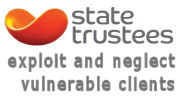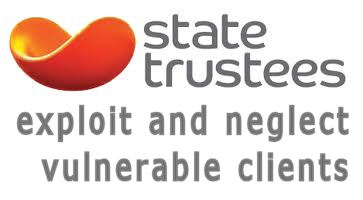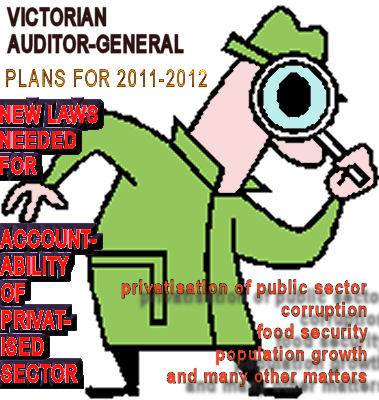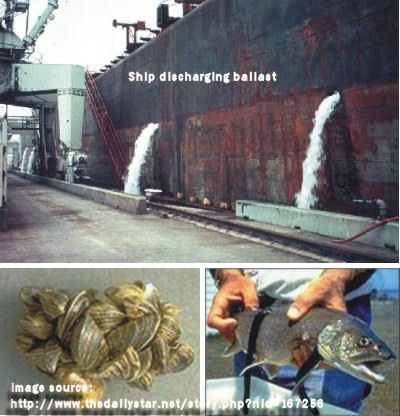3.3 The interests of represented persons
Under the Guardianship and Administration Act 1986 (the Act), State Trustees must act in the best interests of each
represented person.
State Trustees should be
able to demonstrate this by putting in place
appropriate internal control frameworks that focus on the best interests of
represented persons, and subjecting these to regular quality assurance and
testing.
To be consistent with the Act,
these frameworks should include:
- encouraging and
assisting the represented person to become capable ofadministering the estate
-
consulting with them and taking their wishes into account as far as possible.
Critical steps in ensuring that
State Trustees acts in the best interests of represented persons include:
- adequate training of staff
-
access to complete and accurate information when making decisions
- transparent documentation of decisions and reasons
-
sufficient and effective engagement with represented persons
- quality assurance.
3.3.1 Staff skills and capacity
Administering the estates of represented persons can
be complex, intensive and specialised. The requirements of the Act demand a
large, well trained, competent and stable workforce that can establish and
maintain personal relationships with up to 10 000 represented person
clients.
At the time of the audit there were about
140 Personal Financial Solutions (PFS) staff managing the estates of over 10
000 represented persons. About 88 of those staff are caseload managers,
referred to as consultants, who can be responsible for up to 400 clients
at any one time.
State Trustees has been actively developing its
workforce capability with an in-house staff competency program.
Staff competency
State Trustees recognised that heavy workloads, the
need for unique skill sets that can only be developed in-house and consistently
high staff turnover, raised the risks of poor quality service and of
overlooking critical client information.
In 2006, it began a Manageable Caseload Project (MCP)
to improve staff competency and the caseload balance of consultants in the PFS
division. All newly recruited PFS staff now receive six to seven weeks in-house
training and competency assessments. Mandatory ongoing training is also
provided to all consultants according to their duties.
Anecdotal evidence suggests that the MCP improved
service quality, competencies, workload balance and staff morale. State
Trustees has since adopted the principles of the MCP for the whole
organisation.
3.3.2 Information management
Making decisions in the best interests of represented
persons requires accurate and relevant information to be available. This not
only promotes better decision-making, but enables quality assurance, reduces
the risks associated with staff turnover, and assists in meeting accountability
obligations.
State Trustees staff base estate management
decisions primarily on the information in client records, kept in State
Trustees’ Asset and Information Management System, depending on it to be
timely, relevant and complete.
Reviews over the past five years have consistently
identified poor governance and management of information.
Three information management reviews between 2008
and 2010 found weaknesses:
- a 2008 Auditor-General’s report on Records
Management in the Victorian Public Sector found it did not meet the
requirements of sound records management
-
a 2008 internal review on the Security of
Information Assets found no organisational information management and security
policy, framework or supporting standards and an over-reliance on information
technology (IT) for information security
-
a 2010 internal corporate risk review on data
integrity found the absence of a policy and framework for data integrity
contributed to poor data management practices across the business.
Developed in 2007, State Trustees’ IT strategy aimed to,
among other things, understand the key issues for the next five years and
develop a strategic plan.
The strategy identified that while existing business
systems lacked the capacity to meet business needs, some system performance
issues had more to do with poor information management than poor information
technology.
State Trustees
recognised that over the following decade technology initiatives costing $10.1
million needed to be budgeted for.
When consultants refreshed the IT strategy
in 2009 they noted that, except for some activities that related to client
relationship management, only one of the five initiatives had been carried out.
They also noted that staff
were entering unreliable and incomplete client information into State Trustees’
primary client information management system. The review recommended this be
resolved and that State Trustees introduce
a client information governance framework. To date, neither has occurred.
State Trustees
recognises that it needs to improve its information management and began work
to implement an Electronic Document and Records Management System in early
2011.
State Trustees has asserted that qualitative
information about services to represented persons is often captured at a client
or file level, and not expressly summarised in high?level reports.
However, information in client files has often been
found to be incomplete or inaccurate, and State Trustees still considers
records management and data integrity risk controls within the PFS division to
be deficient.
The lack of complete and accurate information on
client files prevents the demonstration of effective engagement with clients.
Most information on client files comes from telephone
conversations with clients and contact with carers, support workers and others.
The quality of the information in communications records is inconsistent. Some
are comprehensive while others are so minimal even the topic is unclear, and
understanding the matter recorded would require personal knowledge of the
client.
Staff turnover
Staff play an important part in effective
information management. High staff turnover puts quality decision-making at
risk where knowledge about individual clients and reasons for past decisions
rests with the assigned consultants.
State Trustees is aware of the effect of
high staff turnover and delays in replacing staff due to the extensive training
required and has taken steps to improve retention rates.
From 2007–08 to 2009–10 there has been a
steady fall in overall staff turnover with turnover in the PFS division in
particular falling from 26.5 to 18.4 per cent overall. However,
retention rates for PFS consultants have not improved between 2006 and 2011.
Almost half of State Trustees’ consultants have been in the role for less than
two years, with almost one quarter for 12 months or less.
Transparency
From a sample of client files, this
audit found that client files had minimal documentation of needs assessments to
inform budget decisions, both at the initial stage and ongoing. The majority of
records reviewed contained little evidence of assessment of the client’s
physical needs and financial circumstances, or detail about their wishes
regarding their assets.
The majority of communication records
did not include sufficient detail to adequately understand the matter discussed
in the record. In most cases, staff rely on their personal knowledge of, and
experience with, the client to ‘interpret’ the information in a communication
record.
Other files indicated that actions
had been taken, for example in complaints files, but contained no information
on follow-up or the outcome of the action.
For two clients, the consultant was
unable to locate the records required for review by the audit.
3.3.3 Engagement with represented persons
As it makes decisions daily on behalf of
society’s most vulnerable individuals, State Trustees must have a relationship
with each client to understand their circumstances, what they want, what their
current needs are and how they would like to live their lives.
State Trustees has a stakeholder engagement strategy
that includes promoting client interests to commercial and community
stakeholders. However, the strategy does not extend to client engagement and
communication. State Trustees has advised that it will review its stakeholder
engagement strategy in 2012–13.
The Community Services Agreement (CSA)
requires State Trustees to visit represented persons within 65 days of being
appointed by the Victorian Civil and Administrative Tribunal to assess their
personal and financial circumstances. However, it is not required to
visit them again.
The CSA does require some type of contact
with each represented person or their carer at least once a year to determine
whether their needs or circumstances have changed. This also enables State
Trustees to adjust their client records accordingly.
Regardless of the CSA obligations, State
Trustees has a responsibility under the Act to consult with represented persons
to ensure it is acting in their best interests.
State Trustees has substantial
point-of-service contact with represented persons. Throughout the year, its
call centre receives almost 300 000 phone calls from clients and carers, and it
provides front counter services, such as cash collections, to around
13 000 clients.
However, quality client engagement directly
between represented persons and their consultants is infrequent. After the
initial visit, only around 5 to 8 per cent of clients are visited each year.
A review of client files found one client
who had never received a visit from a State Trustees consultant.
Staff are expected to notify clients,
carers or family in writing when there is a change in the assigned consultant.
This has not occurred in many cases. One case file showed that the client had
been assigned 15 different consultants over the past five years, but few
letters had been sent to advise the client of these changes.
State Trustees has no client engagement
strategy. State Trustees’ Service Excellence Plan noted a lack of consistency
in the way it engaged with clients.
3.3.4 Quality measurement and assurance
State Trustees performs limited quality
assurance of the services it provides to represented persons.
State Trustees asserts that qualitative information
about services to represented persons is often captured at a client level.
State Trustees relies on team leaders to observe consultants, review files, and
discuss decisions. This is not documented, and State Trustees has no system to
check if this occurs.
The PFS quality review team is responsible for
reviewing each represented person’s file at least once every two years. However
the review focuses on the accuracy of client file data at the time of the
review rather than the quality of ongoing estate administration. Reviewers do
not assess the quality of decisions when doing the review, making it an
inadequate way to monitor whether the best interests of represented persons are
being met.
State Trustees’ two methods of ascertaining
represented persons’ satisfaction with its services are through a client
satisfaction survey, which is not validated against internal performance
benchmarks, and a complaints process that lacks quality assurance.
Client satisfaction survey
The Client Value Index (CVI) is State
Trustees’ only corporate measure of service quality, with improving CVI results
its only service quality objective.
The CVI is an annual measure of client
satisfaction with services. The CVI also meets the CSA obligation to
independently survey represented persons. In 2010 the CVI results for
represented persons showed 82 per cent satisfaction compared to
78 per cent in 2009, passing the target of 80 per cent. However, the
measure was reported at 75 per cent in 2011.
Quantitative data from the CVI survey is
analysed and used to recommend improvements. However, there is no documentary
evidence that State Trustees monitors and reports on their implementation or
effectiveness. State Trustees plans to analyse and develop initiatives from the
qualitative data for the first time in 2011 to contribute to improvements.
While a valid method to monitor client
satisfaction at an aggregate level, the CVI is not supported by internal
analysis of service quality against defined quality targets. In isolation the
survey is not sufficient to demonstrate that the best interests of each
represented person are being met.
Complaints management
State Trustees’ complaints management
framework consists of a complaints handling and dispute resolution policy and
operational procedures, and is generally aligned to better practice.
However, its use demonstrates inconsistent
quality of complaints record keeping, insufficient analysis and no systems for
complainant feedback.
Although the client concerns panel is
effectively handling the small proportion of serious and complex complaints,
State Trustees needs to improve its handling of the other types of complaints
it receives.
A 2009 review recommending implementation
of complaints handling functionality in the client information management
system was rejected on the basis that it would not result in sufficient
improvements on the existing spreadsheet-based complaints register and hard
copy files that were being used for complaints handling. However, staff use the
complaints system inconsistently, with some recording complaints on the
register but not on the client’s electronic file and others recording
complaints on this file but not on the register.
Complaints data reporting to State
Trustees’ board has not been sufficiently analysed to identify and address
performance issues and opportunities for continuous improvement, despite a 2009
internal audit recommending this.
The same internal audit recommended seeking feedback
on satisfaction with the complaints process, but this is still not occurring.
During this
audit, State Trustees advised it has begun to improve its complaints management
with:
-
a review of complaints governance and reporting, including better
data analysis
-
a review of its client concerns panel charter with a view to
giving it greater powers to direct action and mandate systemic changes in
complaints processing
-
the development and implementation of complaints management
functionality in its client information management system.
However, it has not advised how it intends to collect
feedback from complainants about their satisfaction with complaints handling
and resolution.
Recommendations
-
That
State Trustees implement an information governance framework which is aligned
to the principles of good records management.
-
That
State Trustees review and implement strategies to improve consultant turnover
rates, client communications, record keeping, client feedback and all quality
assurance processes.
 "The governance, coordination and oversight of the management of Ramsar sites must improve overall for Victoria to effectively meet its obligations. Monitoring the implementation of management plans also requires improvement. The recommendations are designed to improve gaps in governance, oversight, coordination and monitoring." (Victorian Auditor General)
"The governance, coordination and oversight of the management of Ramsar sites must improve overall for Victoria to effectively meet its obligations. Monitoring the implementation of management plans also requires improvement. The recommendations are designed to improve gaps in governance, oversight, coordination and monitoring." (Victorian Auditor General)![]()

 Public hospitals present hazardous challenges that demand OHS management of the highest standard. The audit found that while there are instances of better practice among the audited public hospitals, there are also significant shortcomings which put staff at unnecessary risk. In addition, weaknesses identified with the role of the department as the health system manager, and with WorkSafe as the OHS regulator, have contributed to the failure to achieve better management of OHS risk by public hospitals. Neither the department nor WorkSafe has a comprehensive understanding of sector-wide OHS risks or emerging trends in public hospitals.
Public hospitals present hazardous challenges that demand OHS management of the highest standard. The audit found that while there are instances of better practice among the audited public hospitals, there are also significant shortcomings which put staff at unnecessary risk. In addition, weaknesses identified with the role of the department as the health system manager, and with WorkSafe as the OHS regulator, have contributed to the failure to achieve better management of OHS risk by public hospitals. Neither the department nor WorkSafe has a comprehensive understanding of sector-wide OHS risks or emerging trends in public hospitals.






 Increasing private-public partnerships, contracting out, privatisation, creation of authorities 'outside government' etc over the past 20 years in Victoria "has led to a steady erosion of accountability to Parliament and the public, as these services and the public monies that fund them fall outside existing accountability frameworks and the mandate of this office." (Auditor General, Victoria) The forward plan also notes concerns about population growth and food security.
Increasing private-public partnerships, contracting out, privatisation, creation of authorities 'outside government' etc over the past 20 years in Victoria "has led to a steady erosion of accountability to Parliament and the public, as these services and the public monies that fund them fall outside existing accountability frameworks and the mandate of this office." (Auditor General, Victoria) The forward plan also notes concerns about population growth and food security.



 "A staggering 120 million tons of foreign ballast water is dumped into Australian ports each year - that's a quarter of the volume of water in Sydney's famous harbour. Professor Gustaaf Hallegraeff believes it's crucial that something be done, because the discharged ballast water can - and does - transport bacteria from one part of the world to another.
"A staggering 120 million tons of foreign ballast water is dumped into Australian ports each year - that's a quarter of the volume of water in Sydney's famous harbour. Professor Gustaaf Hallegraeff believes it's crucial that something be done, because the discharged ballast water can - and does - transport bacteria from one part of the world to another. Victoria's Auditor-General, Des Pearson, this morning tabled the "Environmental Management of Marine Protected Areas" report in the Victorian Parliament: This audit examined how effectively marine protected areas have been managed to protect biodiversity. It assessed the roles of Parks Victoria, and the Departments of Sustainability and Environment and Primary Industries, in the environmental management of marine protected areas. Parks Victoria cannot show that marine biodiversity is being protected or that the related management obligations of applying resources as intended are being discharged. Little environmental management activity is evident across its marine protected areas.
Victoria's Auditor-General, Des Pearson, this morning tabled the "Environmental Management of Marine Protected Areas" report in the Victorian Parliament: This audit examined how effectively marine protected areas have been managed to protect biodiversity. It assessed the roles of Parks Victoria, and the Departments of Sustainability and Environment and Primary Industries, in the environmental management of marine protected areas. Parks Victoria cannot show that marine biodiversity is being protected or that the related management obligations of applying resources as intended are being discharged. Little environmental management activity is evident across its marine protected areas.
 In May, 2010, The Auditor General found that Control of Invasive Plants and Animals in Victoria's Parks was complicated, poorly coordinated, and poorly administered.
In May, 2010, The Auditor General found that Control of Invasive Plants and Animals in Victoria's Parks was complicated, poorly coordinated, and poorly administered. 









Recent comments